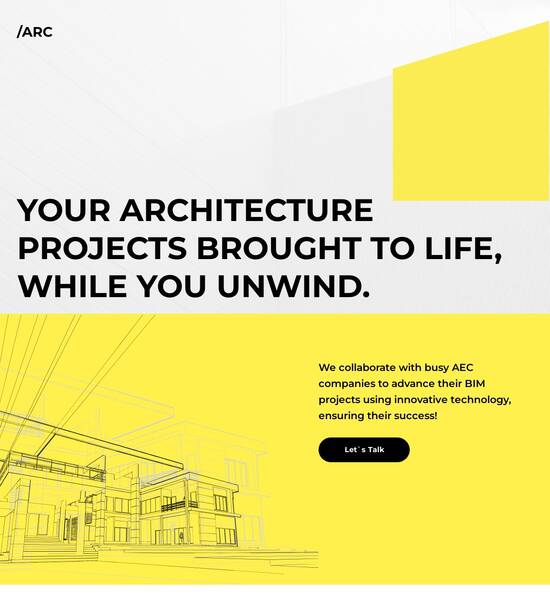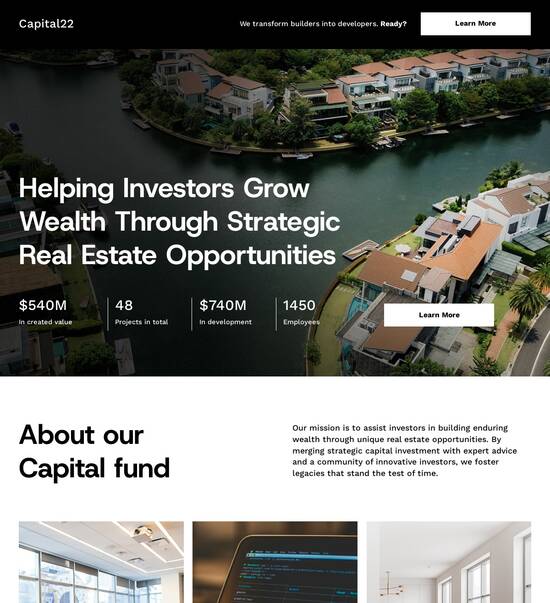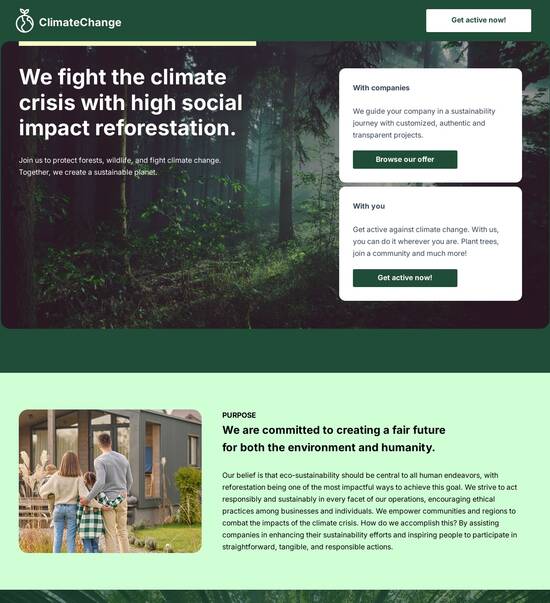
HTML page template for container shipping companies
Use TemplateAbout template
Give your container shipping companies a boost with our professional landing page templates. Ready to turn visitors into customers?
Recommended templates

Easy to build without coding
With the intuitive drag-and-drop builder, anyone on your team can create high-converting pages without any knowledge of code or design. Make enhancements to your landing page with custom widgets using Javascript, HTML/CSS, or third-party scripts.

Multiple layouts for any industry and goal
Select from 500+ landing page layouts built to boost conversions across industry-specific scenarios. Customize them by adjusting fonts, adding images, and generating on-brand content with the AI assistant. Quickly scale with Instablocks® and Global Blocks that you can save, reuse, and update globally.

Loads fast and looks polished on any device
Every template is responsive, which means they present professionally on any device and load blazingly fast with our Thor Render Engine. You can also power them up with Google AMP technology to deliver an unparalleled mobile experience and drive higher conversions.

Robust analytics & experimentation
Get real-time updates and reporting across all your devices, showing the number of visitors, conversions, cost-per-visitor, and cost-per-lead. Launch AI-powered experiments, run A/B tests, and use heatmaps to analyze user behavior, then optimize your landing page to maximize conversions.







Easy to build without coding
With the intuitive drag-and-drop builder, anyone on your team can create high-converting pages without any knowledge of code or design. Make enhancements to your landing page with custom widgets using Javascript, HTML/CSS, or third-party scripts.
Multiple layouts for any industry and goal
Select from 500+ landing page layouts built to boost conversions across industry-specific scenarios. Customize them by adjusting fonts, adding images, and generating on-brand content with the AI assistant. Quickly scale with Instablocks® and Global Blocks that you can save, reuse, and update globally.
Loads fast and looks polished on any device
Every template is responsive, which means they present professionally on any device and load blazingly fast with our Thor Render Engine.
Robust analytics & experimentation
Get real-time updates and reporting across all your devices, showing the number of visitors, conversions, cost-per-visitor, and cost-per-lead. Launch AI-powered experiments, run A/B tests, and use heatmaps to analyze user behavior, then optimize your landing page to maximize conversions.
All the features you need to build lead-generating landing pages
Explore more featuresLearn how to build top-performing landing pages for any goal
FAQs
Leading the way in building high-performing landing pages





Maximizing ROI with Instapage's landing page and CRO platform
Instapage stands out as the most powerful landing page and conversion rate optimization (CRO) platform available today, designed specifically for marketing professionals in various industries such as business services, education, and financial services. This guide will walk you through the step-by-step process of utilizing our platform to create high-performing landing pages that not only capture leads but also maximize your digital marketing efforts.
Understanding the value of landing pages
Landing pages are pivotal to any online marketing strategy. They serve as the first impression potential customers have of your brand, thus emphasizing the need for effective design and content. With Instapage, you gain access to 100+ ready-to-use templates and pre-built lead generation elements that simplify the page creation process, allowing you to focus on messaging rather than technicalities.
- High-converting templates: Instapage offers more than 100 conversion-focused layouts, ensuring you find the right design for your audience's needs.
- User-friendly design process: Our intuitive page builder allows you to tweak elements easily without the need for coding or developer input.
- Lead generation tools: Integrated elements such as forms and call-to-action buttons are seamlessly included in your templates to enhance lead capture.
Step 1: Create personalized landing pages
Personalization is key in enhancing user engagement. Here's how you can craft a landing page tailored to your audience’s distinct preferences:
- Dynamic text replacement: Tailor your messaging to different segments for a deeper connection.
- AdMaps: Align specific ads to dedicated pages to ensure consistency in your marketing efforts.
- Audience metrics tracking: Use our data tools to assess performance at a granular audience level.
Step 2: Optimize for higher conversions
Once your landing page is live, optimization is essential for achieving the highest possible conversion rates. Implement these strategies:
- A/B testing: Run experiments on different page elements to identify winning variations.
- Heatmaps: Utilize detailed heatmap analytics to pinpoint areas where users engage most.
- Continuous iteration: Use analytics dashboards to measure performance and refine pages continually.
Step 3: Collaborate for efficiency
Effective collaboration speeds up the process from idea to execution. Leverage these features:
- Real-time editing: Work alongside team members and stakeholders, allowing for immediate feedback.
- Secure sharing: Easily distribute your pages to external parties while ensuring data protection.
- Instant feedback loops: Gather insights and suggestions quickly to improve campaign execution.
By following these steps, you can harness the full potential of Instapage to create personalized, high-converting landing pages that drive your marketing outcomes significantly.
Now is the time to boost your digital marketing campaigns with Instapage’s robust tools. Sign up today and transform how you approach landing page creation!
People also ask about HTML page template for container shipping companies
HTML page templates for container shipping companies: A comprehensive guide
The landscape of container shipping: An overview
Container shipping plays a crucial role in the modern global trade landscape. It involves transporting goods in standardized containers, allowing for efficient handling and transfers across multiple modes of transportation. This method has significantly influenced the way businesses engage in international trade, as it enables companies to reduce costs and improve delivery times.
Key players in the container shipping industry include shipping lines, freight forwarders, and port operators. Together, they contribute to a complex supply chain that requires seamless collaboration and coordination. As businesses expand internationally, understanding the importance of container shipping becomes essential for navigating global markets.
The digital landscape has transformed the way companies interact with their clients and partners. Establishing a robust online presence is vital for container shipping firms to showcase their capabilities and services. However, many companies face challenges in effectively representing themselves online, dealing with outdated interfaces and lacking user-centric designs.
Understanding HTML page templates for container shipping companies
HTML page templates serve as pre-designed web pages that can be customized to reflect the unique branding and service offerings of a company. They streamline the web design process, allowing container shipping companies to quickly set up a professional website without needing extensive coding knowledge. By utilizing templates, companies can focus on content while maintaining a consistent aesthetic across their sites.
The specific needs of container shipping companies warrant templates that not only reflect their branding but also comply with regulatory requirements. Websites must effectively communicate essential information regarding shipping procedures, services, and contact details while ensuring an intuitive navigation experience for various stakeholders, from clients to partners.
Essential features of a shipping company HTML template
Responsive design is a principal feature of modern web templates. Given that many users access shipping company websites via smartphones or tablets, ensuring that these sites provide an optimal viewing experience across all devices is critical. Responsive layouts adjust dynamically to accommodate varying screen sizes and orientations.
Fluid grids allow for flexible resizing of page elements.
Media queries enable the application of specific styles based on the device's characteristics.
Flexible images and videos scale appropriately within their containing elements.
The integration of key functionalities such as contact forms and shipment tracking displays makes shipping company websites not only informative but also interactive. Contact forms help facilitate customer inquiries efficiently, while real-time updates on shipment statuses cater to clients' need for information, enhancing overall user satisfaction.
Incorporating advanced functionalities
Using `document.addeventlistener` enables shipping companies to create interactive experiences on their websites. By listening for user actions, such as clicks or form submissions, companies can dynamically update content and provide responsive feedback. This interactivity improves user engagement and encourages visitors to explore various services.
Real-time cargo tracking notifications keep clients informed about their shipments.
Responsive feedback after form submissions reassures users that their inquiries have been received.
Ensuring strong performance on the website involves managing scripts and files effectively with the `DOMContentLoaded` event. This event signals when the initial HTML document has been completely loaded and parsed, making it an ideal moment to execute scripts. By prioritizing critical scripts and deferring non-essential ones, companies can improve page load times.
Designing for user engagement and conversion
Engaging content sections are essential for keeping visitors interested on shipping company websites. Highlighting the various shipping services and specialties not only informs potential clients but also showcases what sets the company apart from competitors. Additionally, including testimonials and case studies can help build trust, reinforcing the company’s credibility and reliability.
Detailed descriptions of specialized shipping services can attract targeted clientele.
Visual elements such as infographics related to shipping processes enhance comprehension and retention.
Prominently displaying case studies provides social proof and encourages decision-making.
Incorporating graphics relevant to shipping and logistics enhances visitors' understanding of services offered while creating a visually appealing experience. Consistent branding across all design elements further cultivates user loyalty, as clients appreciate a cohesive and professional presentation.
SEO best practices for container shipping websites
Implementing effective search engine optimization (SEO) strategies is vital for container shipping companies aiming to improve their online visibility. This begins with thorough keyword research specific to shipping. Identifying relevant keywords allows companies to optimize their content, making it easier for potential clients to find them through search engines.
Using tools like Google Keyword Planner to discover high-traffic keywords.
Analyzing competitors' keywords to identify opportunities.
Incorporating local SEO tactics to target regional clients.
Page structure and metadata optimization play a critical role in enhancing search results visibility. Proper use of heading tags, such as H1, H2, and H3, helps create a clear hierarchy that search engines can easily parse. Additionally, implementing rich snippets can provide additional context to search results, improving click-through rates by making listings more informative.
Accessibility and compliance considerations
Website accessibility is a fundamental aspect of modern web design. By adhering to Web Content Accessibility Guidelines (WCAG), container shipping companies can ensure that their websites are usable for individuals with disabilities. Implementing best practices empowers all users to engage with content regardless of their capabilities.
Providing alt text for images enhances access for visually impaired users.
Ensuring sufficient color contrast improves readability for users with visual impairments.
Utilizing ARIA roles can improve navigation for screen reader users.
Regulatory compliance is particularly significant in the shipping industry. Shipping companies must be aware of applicable regulations and ensure that their website content adheres to these guidelines. Strategies for ensuring compliance include regular audits of website content and design against legal requirements, as well as providing clear privacy policies to enhance transparency.
Customization and scalability of HTML templates
Customizing HTML templates allows shipping companies to tailor their online presence to reflect their unique branding and vision. Adjustments include altering color schemes, fonts, and graphic elements to provide a consistent representation of the company's identity. User-centric adjustments improve visitor engagement and satisfaction, creating a more meaningful experience.
Utilizing company logos and color palettes for branding consistency.
Adjusting layout structures to prioritize important services or information.
Incorporating unique visuals that tell the company's story.
Scalability is an essential consideration when choosing HTML templates. As shipping companies grow, their websites must adapt to accommodate new features and functionalities. Templates designed with adaptability in mind can easily integrate additional services, client portals, and product showcases as business needs evolve.
Real-world examples of successful container shipping websites
Examining successful container shipping websites reveals innovative uses of HTML templates that enhance user experience and operational efficiency. Companies that excel online leverage well-structured designs and integrate useful functionalities to cater to their audience's needs. Effective implementation not only increases customer engagement but also significantly contributes to growth.
A leading shipping firm uses real-time tracking features integrated into their HTML template, resulting in improved customer satisfaction.
Another company focuses on showcasing their services through engaging visuals and intuitive navigation, driving higher conversion rates.
Successful case studies highlight how a clear call to action motivates users to reach out for services.
Key takeaways from these implementations emphasize the importance of user experience and mobile compatibility. Vigilantly testing designs for usability and responsiveness ensures that potential clients find what they need quickly and efficiently, paving the way for smoother interactions and higher conversion rates.
Future trends in shipping industry web presence
As the shipping industry evolves, so too will its web design trends. Emerging technologies such as artificial intelligence and machine learning are poised to redefine user experiences. Shipping companies may adopt interactive elements and personalized content, enhancing user engagement and satisfaction.
AI-driven chatbots can provide instant support for clients inquiring about services.
Personalized content based on user behavior can boost conversion rates.
Enhanced web security will become increasingly important to protect customer data.
Looking to the next 5-10 years, container shipping websites will likely evolve to better meet user expectations and leverage advanced technologies. Companies that proactively adopt these trends will position themselves ahead of the competition. Building adaptable templates and maintaining agile web strategies will be crucial for long-term online success.
Ready to skyrocket conversions?
Supercharge your ad campaigns with high-performing landing pages
Get started














